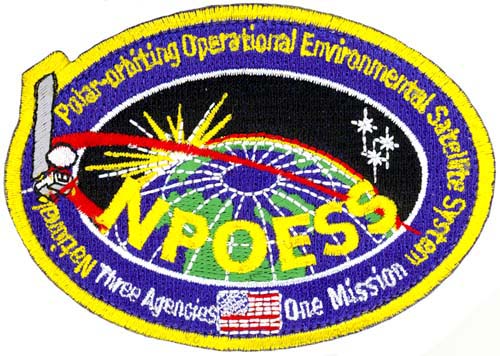Description
Computer made/mounted on velcro 3.5 inch-90mm
National Polar-orbiting Operational Environmental Satellite System (NPOESS)
The National Polar-orbiting Operational Environmental Satellite System (NPOESS) is the next generation of low earth orbiting environmental satellites. The NPOESS will circle the Earth approximately once every 100 minutes. During these rotations, the NPOESS will be providing global coverage, monitoring environmental conditions, collecting, disseminating and processing data about the Earth’s weather, atmosphere, oceans, land, and near-space environment.
The NPOESS system will be able to monitor the entire planet and provide data for long-range weather and climate forecasts. The data gathered by the NPOESS will aid in reducing the potential loss of human life and property by allowing more efficient disaster planning and response to severe weather conditions such as tornadoes and floods.
Citizens will benefit from the satellite’s data in the areas of general aviation, agriculture, and maritime activities. Military users will benefit from the NPOESS as well, tactically and strategically. The NPOESS will permit the military to capitalize on favorable weather conditions or avoid harsh weather conditions that could hinder maneuverability.
The NPOESS will collect a massive amount of very precise earth surface, atmospheric and space environmental measurements from a variety of on-board sensors. This volume of data will allow scientists and forecasters to monitor and predict weather patterns with greater speed and accuracy.
NPOESS Program
The Polar-orbiting Operational Environmental Satellite (POES), operated by the Department of Commerce supports a broad range of environmental monitoring applications. The parallel polar program in the Department of Defense is the Defense Meteorological Satellite Program (DMSP) , which has been collecting weather data for U.S. military operations for almost four decades.
In 1994, The National Performance Review, initiated during the Clinton Administration reported that converging the existing polar systems from the Department of Commerce (DOC) and Department of Defense (DoD) would result in a more cost efficient integrated system. Converging U.S. polar-orbiting satellite programs, the National Polar-orbiting Operational Environmental Satellite System will reduce the number of polar-orbiting systems from four U.S. satellite groups to three.
As a result, in May 1994, a convergence plan was submitted to the U.S. Congress stating NPOESS can eliminate the financial redundancy of acquiring and operating polar-orbiting environmental satellite systems, while continuing to satisfy U.S. operational requirement for data from these systems. The President endorsed this initiative, signing Presidential Decision Directive NSTC-2. The current NPOESS mandate extends to the year 2026.
The NPOESS increases the timeliness and accuracy of severe weather event forecasts. To achieve its mission, NPOESS has undertaken a far-reaching program of sensor development and satellite transition and evolution to provide complete coverage of meteorological conditions for civil, military, and scientific purposes.
The NPOESS Program is managed by the tri-agency Integrated Program Office (IPO), employing personnel from the Dept. of Commerce (DOC), Dept. of Defense (DoD) and the National Aeronautics and Space Administration (NASA). The Integrated Program Office has initiated planning and development programs of satellite transition, sensor and system development and user training.
Nunn-McCurdy Program Restructure
The NPOESS program has gone through a restructure brought about by the breach of certain congressionally mandated thresholds contained within the Nunn-McCurdy Amendment, a part of the 1982 Defense Authorization Act. These thresholds require that a program notify congress if a program’s Program Acquisition Unit Cost (PAUC) or the Average Procurement Unit Cost (APUC) increases by more than 15%. Additionally, Nunn-McCurdy also requires the Secretary of Defense certify to Congress four specific areas if the PAUC or the APUC increases by more than 25%.
NPOESS was declared breaching the 15% level in September 2005 and the 25% level in January 2006. As a result of the 25% breach, the NPOESS program underwent a Nunn-McCurdy Certification process from January to June 2006. This resulted in a decision by the Undersecretary of Defense for Acquisition, Technology, and Logistics, and supported by the NPOESS EXCOM, to restructure the NPOESS program.
The restructured program:
deleted the 2130 NPOESS spacecraft and instruments (and directed the deleted orbit’s mission requirements be met with the METOP satellite)
de-manifested the ERBS, TSIS, Altimeter, SESS, and APS sensors as well as the Survivability sensor
directed NPOESS fly with the SEM and CERES instruments instead of ERBS and SESS
de-manifested the Limb sensor from OMPS for both the NPOESS Preparatory Project and NPOESS 1330 satellite
OMPS Limb was subsequently re-manifested by the EXCOM when NOAA and NASA funded it. The restructured program also included only the first two operation satellites (C1 and C2) with an option for their replacements (C3 and C4).
